Banana Peels in the Garden. Yes-Here’s Why It Works
You might not realize that banana peels are more than just waste; they’re a treasure trove of nutrients for your garden. Rich in potassium, phosphorus, and calcium, these peels can significantly enhance plant health and productivity. By integrating them into your garden practices, you can foster stronger roots, vibrant blooms, and resilient plants. Curious about how to maximize these benefits and improve your garden’s ecosystem? Let’s explore the practical applications of banana peels in your gardening routine.
Key Takeaways
- Banana peels are rich in potassium, phosphorus, and calcium, essential nutrients that promote plant growth and productivity.
- Chopping and burying banana peels in soil enhances nutrient release, benefiting plants directly.
- Soaking banana peels in water creates a nutrient-rich liquid fertilizer for effective root application.
- Composting banana peels enriches compost with vital nutrients, supporting a healthy garden ecosystem.
- Using banana peels improves soil health by increasing organic matter and fostering beneficial microbial activity.
Nutrient Content of Banana Peels
Banana peels are often overlooked, but they pack a nutritional punch that can benefit your garden.
When you consider banana peel fertilizer, you’ll find it’s rich in essential nutrients like potassium, phosphorus, and calcium.
Potassium helps with root development and disease resistance, while phosphorus promotes flowering and fruiting.
Calcium strengthens cell walls, improving plant structure and growth.
By incorporating banana peels into your compost or directly into the soil, you’re not just reducing waste; you’re enhancing soil health. Additionally, transforming banana peels into fertilizer allows you to maximize their benefits while supporting sustainable gardening practices.
Understanding the nutrient content of banana peels allows you to harness their potential, making them a valuable addition to your gardening routine.
Benefits for Plant Growth
Using banana peels in your garden can significantly boost plant growth due to their rich nutrient content, particularly potassium and phosphorus.
These elements not only enhance soil quality but also improve flowering and fruiting in your plants.
Additionally, banana peels can act as a natural pest deterrent, helping to protect your garden from harmful insects while promoting overall health. Moreover, their nutrient content can help enrich compost, making it a valuable addition to your gardening practices.
Nutrient-Rich Fertilizer
In the realm of organic gardening, banana peels serve as a nutrient-rich fertilizer that can significantly enhance plant growth.
Packed with potassium, phosphorus, and calcium, these peels promote strong root development and improve overall plant health.
When you chop and bury banana peels in your garden, they decompose quickly, releasing essential nutrients directly into the soil.
This process encourages better water retention, leading to more robust plants.
Additionally, the natural sugars in the peels can boost beneficial microbial activity in the soil, creating a thriving ecosystem that supports growth.
Your plants will thank you for this simple, effective addition!
Pest Deterrent Properties
One of the lesser-known benefits of banana peels in the garden lies in their pest deterrent properties, which can be a game-changer for plant growth.
The peels contain compounds like potassium and magnesium that help repel pests, including aphids and spider mites.
When you bury the peels in your soil or place them near plants, they release these compounds, creating a natural shield against unwanted insects.
Additionally, banana peels attract beneficial organisms, such as earthworms, which further enhance soil health.
How to Use Banana Peels in the Garden
Banana peels, often discarded as kitchen waste, are a treasure trove of nutrients that can significantly benefit your garden.
To use them effectively, chop the peels into small pieces and bury them in the soil around your plants.
This method allows essential nutrients like potassium and phosphorus to release gradually, enriching the soil.
You can also soak peels in water for a few days, creating a nutrient-rich liquid fertilizer.
Pour this solution directly onto your plants’ roots.
Lastly, place whole peels in your compost pile, where they’ll break down and boost the nutrient content of your compost.
Additionally, banana peels are rich in homemade fertilizer that can help improve soil quality and plant health.
Happy gardening!
Composting With Banana Peels
Composting with banana peels is an excellent way to recycle kitchen waste while enhancing your garden’s soil health. These peels are rich in potassium, phosphorus, and calcium, essential nutrients for plant growth. When you add them to your compost pile, they break down quickly, enriching the mix. Additionally, banana peels are one of many common household items that can be composted, promoting eco-friendly waste management practices.
Here’s a quick look at the benefits of composting banana peels:
| Nutrient | Benefit | Amount in Banana Peel |
|---|---|---|
| Potassium | Flowering & fruiting | 358 mg |
| Phosphorus | Root development | 36 mg |
| Calcium | Cell wall structure | 54 mg |
Using banana peels in compost boosts your garden’s vitality.
Attracting Beneficial Insects
Adding banana peels to your compost not only enriches the soil but also plays a role in attracting beneficial insects to your garden. The high potassium and phosphorus content in banana peels serves as a food source for various insects. Ladybugs, lacewings, and pollinators are drawn to the nutrients, helping control harmful pests while promoting pollination. Additionally, the decomposing peels emit a sweet scent that lures these helpful insects. Moreover, certain beneficial weeds can further enhance this effect by creating a more inviting habitat for these insects.
Enhancing Soil Health
Incorporating banana peels into your gardening routine significantly enhances soil health. These peels decompose, releasing essential nutrients like potassium, phosphorus, and calcium, which promote robust plant growth. You’ll notice improved soil structure and moisture retention as well. Additionally, using banana peels helps to increase organic matter content, which is vital for overall soil fertility.
| Nutrient | Benefit |
|---|---|
| Potassium | Strengthens roots |
| Phosphorus | Encourages flowering |
| Calcium | Prevents blossom end rot |
| Organic Matter | Improves soil aeration |
Using banana peels not only enriches your soil but also fosters a sustainable gardening practice, making your garden thrive naturally.





